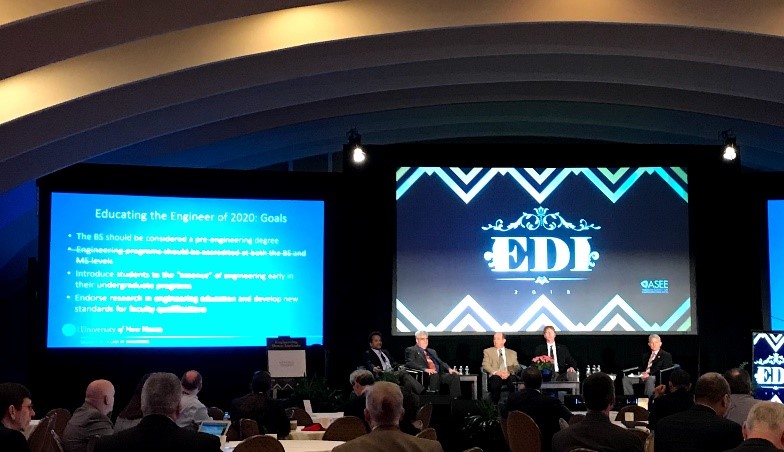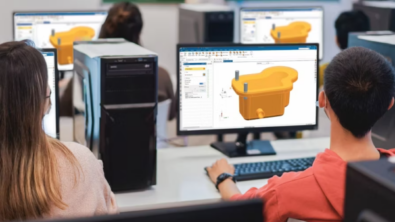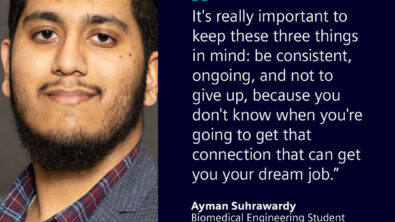Deans share engineering education best practices and challenges at ASEE Engineering Deans Institute

This month engineering deans across North America convened at the American Society of Engineering Education’s annual Engineering Deans Institute. There was a wide range of topics discussed about the current and future state of engineering education. I left with optimism that engineering deans want stronger industry engagement and are open to new methods and models for improving the skillset of future engineers. I’ll summarize a few outtakes around key themes here.
Cool ideas
Throughout the event, deans shared “cool ideas” in short form like TED talks. They covered a diverse set of topics, including cross-disciplinary programs, project-based learning, entrepreneurial approaches, early STEM outreach, industry vertical programs, and diversity and inclusion success stories. Here are a few that stuck out to me.
Dean Yannis Yortsos of the USC Viterbi School of Engineering presented on Heroic Engineering, which cultivates a mindset of social consciousness in future engineers. Using the volunteer platform app Tribu, engineering students on campus collectively volunteer 100,000 hours annually on projects like refugee camp improvements and artificial intelligence for social good.
Dean Kazem Kazerounian of the University of Connecticut (UCONN) shared an industry vertical program. UCONN set up a Naval Institute for Undersea Vehicle Technology to address the state and the U.S. Navy’s need for advanced submarine technology. The institute provides applied research, accelerated technology transition and develops the next-generation workforce.
Associate Dean David Erickson of Cornell Engineering shared how they created a Commercialization Fellows program, providing mentoring and real-world experience to teach engineers to be entrepreneurial, especially with the technology they’ve developed. Students are paired with the school’s MBA teams to help them analyze business opportunities for their technologies.
University of Arkansas and North Carolina State deans shared a joint program to increase the number of engineers serving the country through a Congressional engineering internship program that began at the state level and has grown to the federal level.
Dean Jennifer Curtis of the University California Davis shared an innovative student transfer pathway program. A large percentage of their enrollment comes through the California Community College system, and nearly 70 percent of them are from minority backgrounds, and most are first-generation students. A program called Avenue-E provides them with a strong support network through a cross-disciplinary cohort group.
Nearly a third of the deans I spoke with have new buildings in progress. One cool idea shared by Dean Paul Tikalsky of Oklahoma State was an interdisciplinary discovery lab to break down the undergraduate learning silos and launch entrepreneurial projects. Students agreed to increase their fees $20 a credit to fund the staff and the operations of the lab – called Endeavor. In the evening, the lab is a maker-space for all students. Similarly, the Colorado School of Mines has a design studio that runs like a multidisciplinary consulting firm. Projects have included a prosthetic arm for golfing and a climbing wall for the visually impaired.
The topic of interdisciplinary learning was a recurring theme at EDI, with University of California Los Angeles (UCLA) telling us about a computational medical program that combines computer science, big data analytics and medicine. Carnegie Mellon discussed its new major in engineering and arts.
Communication
In several sessions we discussed the need for strong communication skills in addition to strong engineering skills. With the event being held in New Orleans, a panel addressed flood protection from an engineering and public policy perspective. Jean Vossen of the U.S. Corp of Engineers shared many developments in the Corp since Hurricane Katrina, but highlighted communication as an ongoing challenge, asking at one point, “Are engineers the best communicators?” Emad Habib, professor of civil engineering at the University of Louisiana at Lafayette, also noted, “We’ve made our field too complicated to explain to the public.”
Both the engineering and communication challenges could serve as topics to inspire future engineers, and as subjects for compelling student projects. In fact, several sessions emphasized engaging students through the National Academy of Engineering’s Grand Challenges. Future engineers want to tackle larger social challenges and serve as stakeholders in their communities and world.
Matt Ohland, professor of engineering education at Purdue University, shared how they introduce students to engineering early to improve retention and reduce changes in majors after the first year. He highlighted the connection students can feel to being an engineer long before they’ve graduated, noting, “Students call themselves engineers before they have a degree or license, and that’s not the same for other professions like doctors or lawyers.”
One of the more interesting sessions that touched on communications was done via an acting troupe to highlight unconscious bias in considering faculty for tenure. As several deans noted in side discussions, this is a challenge beyond race and gender as 50 percent of their faculty are international, so there can be cultural biases at work.
Engineering 2020

Deans looked back over the past 14 years since the National Academy of Engineering published The Engineer of 2020. A panel shared some best practices and areas of progress as well as continued challenges.
The Engineer of 2020 report noted, “Providing a broad engineering education to students has become an enormous challenge…only become more daunting as the information on new science and technology continues to explode and new and totally unanticipated technologies, requiring even more specialization, emerge in the future.”
Deans repeated the challenge of how to develop students (and educators) for jobs that do not exist, noting the daunting pace of technological changes. They observed it is difficult to pack any more in the typical four-five year program, which the Engineer of 2020 report foreshadowed, reporting, “Engineering education must avoid the cliché of teaching more and more about less and less, until it teaches everything about nothing.”
Key tenets of the report highlighted by the panel:
- The bachelor of science should be considered a pre-engineering degree
- Introduce students to the essence of engineering early in their undergraduate programs
- Endorse research in engineering education and develop new standards for faculty measurement
 Engineer 2020 Panel at EDI
Engineer 2020 Panel at EDI
The Engineer of 2020 report emphasized “the comfortable notion that a person learns all that he or she needs to know in a four-year engineering program just is not true and never was. Not even the fundamentals are fixed, as new technologies enter the engineer’s toolkit. Engineers are going to have to accept responsibility for their continual reeducation, and engineering schools are going to have to prepare engineers to do so by teaching them how to learn. Engineering schools should also consider organizational structures that will allow continuous programmatic adaptation to satisfy the professional needs of the engineering workforce that are changing at an increasing rate.”
There are mixed feelings on the role of massive open online courses. Some see them as purely focused on degreed individuals for lifelong learning versus some seeking credentials through online learning as an alternate to a degree, especially to address where that programmatic adaptation isn’t happening. Which prompted a question from the audience about whether we see degreed engineering going away and being replaced by new methods.
The answer is no, but the pipeline continues to be a challenge. One dean noted that even though U.S. engineering schools made good on their promise to President Barack Obama to increase graduates by 20 percent to address grand challenges, industry has told them that’s not enough. Industry needs more and will seek candidates through alternate pathways to meet demand.
I was part of a panel titled, “Preparing Engineering Students for Employment with New Credential Models” to discuss this. I shared with the audience our research with Tech Clarity to emphasize the specific skills manufacturers told us they want additional focus on – like product costing and manufacturability.
 Source: Tech Clarity
Source: Tech Clarity
http://www.siemens.com/plm/closetheskillsgap
I shared some of the new methods and models Siemens is involved with both inside and outside the company, from apprenticeships to supporting competence and category level certifications as well as online specializations.
We had some good discussion on the role of industry in helping schools give students opportunities to apply technology without the onus being on the school to act as subject matter experts on the latest capabilities. We also discussed the value of software vendors providing packaged curriculum in emerging technologies like systems driven product development and additive manufacturing.
Let us know if you’re attending any upcoming education or industry events so we can connect live and discuss engineering education in more detail. In the meantime, stay tuned to our educator website for the latest resources.
– Dora


